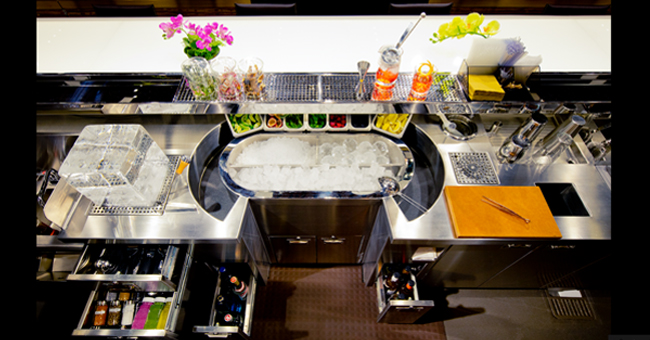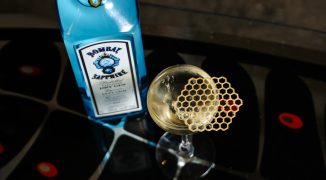No bar design is perfect. Once you’ve worked one busy night behind a bar, you quickly start to notice what works – and what doesn’t. But the difference is all in the details, and some designers are building bars that take bartenders’ needs into account.
Designing with bartenders in mind is “especially important because they’re going to be behind this bar. They’re going to be the ones who bring in revenue to your business every day,” says Francesco Lafranconi, executive director of mixology and spirits education of Southern Wine & Spirits of Nevada. When you’re spending 8-10 hours behind the bar, ergonomic design impacts your health and efficiency.
And with the ever-growing demand for craft cocktails, the number of ingredients stored behind the bar keeps growing. With space at a premium, bar designers have to be smarter than ever to incorporate both storage and room to move into their designs. Even then, they face some common challenges: space, efficiency in service, and budget.
Space
Much of the time, a bar is fully or partially built before a consultant is brought in to optimize it. If the layout’s already set, “the client has to work with what they have, and there’s not much you can do about it,” says Lafranconi.
“Most architects have a one-size-fits-all approach to design, and that doesn’t necessarily work,” says Josh Durr, founder of Hawthorne Beverage Group. “Depending on your scope and idea for the project, you have to make the space functional from both a customer service and the bartender’s standpoint.”
Even if the bar hasn’t been built, it’s not uncommon for an interior designer to have already allocated a space for a specifically shaped bar. Their plans often don’t take into account the bar’s need for storage and refrigerators. In some cases, the bar may not even have back-of-house storage.
It’s a problem that Pouring Ribbons’ Joaquín Simó knows all too well. By building a very tall back bar with built-in steps and putting glass fridges and ice freezers above the stations, he’s made the most of the space he has. These small changes serve two purposes: shaving seconds off prep time and compensating for not having a support staff.
But the most touted aspect of his design is his speed rack. “The bottles are positioned next to each other in the speed rail according to the drink and the specific order we want the drink built in,” he says. “Your hand falls naturally next to the bottle you’ll use next.”
Efficiency
A bartender’s speed and efficiency are largely determined by the space they’re working in. Many bars are adopting “pivot point” designs, or layouts where the bartender never has to move more than a step away from their station.
One of the most interesting solutions is Lafranconi’s racetrack underbar design. After finding that he was getting exhausted after just a few hours of working an event, he was determined to implement a design he’d thought up years before. Thus, the race track design was born. “It’s an oval, and the inner circle is basically an adjustable, removable two-compartment sink.”
The speed rail runs around the lip of the sink, but has a small opening for the bartender, says Lafranconi. “From hip to hip, there is about 25 inches of space. So it also promotes a healthy diet.”
“I think bartenders should be respected to the point that they should be able to work in an ergonomically driven bar environment,” he says. “You have to keep in consideration how you can provide the bartender with a comfortable workspace and improve outward efficiency.”
Time and Money
Bar designers also face budgetary constraints, and the pressures of a construction schedule. “Designing bars should be very specific to that bar program,” says Durr. “You’re building the bar around that. You’re not building a bar that you’re trying to retrofit.” Once you know what tools you need, you can build a bar that will make your program most efficient.
“There’s a finite number of hours that a bar is open, and within that, there’s a finite number of hours when the bar is going to be busy,” says Adam Geissler of Hawthorne Beverage. “If you can make 15-20 extra drinks per night, at the end of the year, that’s a lot of money.”
This is the point where communication often fails. Bartenders and consultants often know exactly what they need, but they can’t always convey it to the architect or the contractor. Luckily, presenting it as a monetary benefit can be a relatively easy way to present it to clients.
“Make it into a hypothetical,” says Durr. “When you lay that out and give it to clients, they have real, tangible numbers that they can put their hands on.” Seeing the financial benefits of their investment can make them more likely to adopt ergonomic measures that will also benefit their bartenders.
“This is the foundation of how the bar functions,” says Durr. “It’s building the house before you realize what you need out of it.” But at the end of the day, “the only limitations on what you can build are your imagination – and your budget.”




